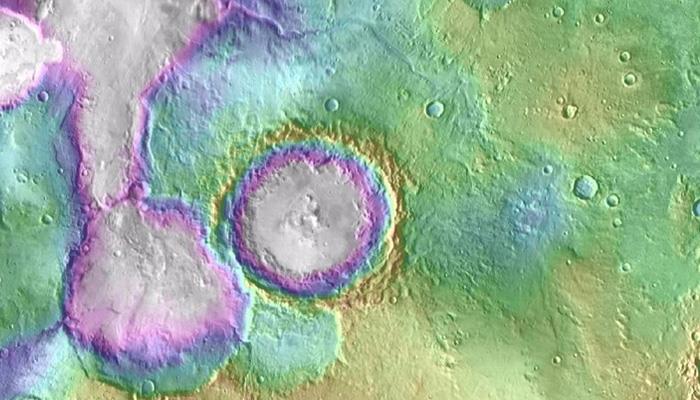NASA has found evidence that lakes and snowmelt-fed streams on Mars formed much later than previously thought.
Scientists have previously documented an earlier era of wet conditions on ancient Mars.
However, new observations — collected by the NASA’s Mars Reconnaissance Orbiter and analyzed by scientists at the Jet Propulsion Laboratory — have revealed that lakes and streams appeared roughly a billion years later.

NASA
NASA says these results provide insight into the climate history of the Red Planet and suggest the surface conditions at this later time may also have been suitable for microbial life.
“We discovered valleys that carried water into lake basins,” said Sharon Wilson of the Smithsonian Institution, Washington, and the University of Virginia, Charlottesville. “Several lake basins filled and overflowed, indicating there was a considerable amount of water on the landscape during this time.”
Wilson and colleagues found evidence of these features in Mars’ northern Arabia Terra region by analyzing images from the Context Camera and High Resolution Imaging Science Experiment camera on the Mars Reconnaissance Orbiter and additional data from NASA’s Mars Global Surveyor and the European Space Agency’s Mars Express.
Researchers also nicknamed the ancient of lakes and streams the Heart Lake valley system.
On mapping the extent of stream-flow in “fresh shallow valleys” and their associated former lakes, researchers suggest that the runoff that formed the valleys may have been seasonal.
To bracket the time period when the fresh shallow valleys in Arabia Terra formed, scientists started with age estimates for 22 impact craters in the area, says NASA.
They concluded that this fairly wet period on Mars likely occurred between two and three billion years ago, long after it is generally thought that most of Mars’ original atmosphere had been lost and most of the remaining water on the planet had frozen.
Researchers also noted that the characteristics of the valleys support the interpretation that the climate was cold.
“The rate at which water flowed through these valleys is consistent with runoff from melting snow,” Wilson said, “These weren’t rushing rivers. They have simple drainage patterns and did not form deep or complex systems like the ancient valley networks from early Mars.”
Scientists also found similar valleys occur elsewhere on Mars between about 35 and 42 degrees latitude, both north and south of the equator, suggesting these freshwater systems formed on a global scale rather than a local or regional scale.
The findings will likely prompt more studies to understand how conditions warmed enough on the frozen planet to allow an interval with flowing water. One possibility could be an extreme change in the planet’s tilt, with more direct illumination of polar ice.
The findings have been published this week in the Journal of Geophysical Research: Planets. Agency
19 Sept, 2016





